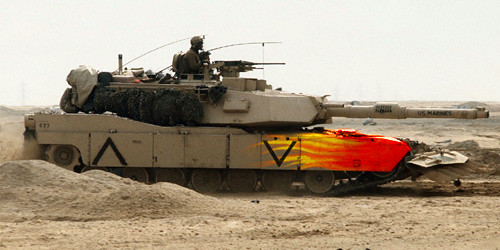Much has been made of the Army's cold feet towards the Israeli active defense system called Trophy. I've done enough research over the years into the marketing practices of defense firms and each recurring story about Trophy ends up smelling like a typical strategy used by Israeli vendors. Since every Israeli is essentially a citizen soldier, the public is very sensitive to military casualties, each one frequently resulting in extensive coverage in the Israeli press.
Israeli defense firms like Rafael or Israeli Military Industries have a reputation for taking the case for a particular piece of defense equipment (especially defensive equipment) to the streets. By constantly hammering home the message of that the widget in question is essential for protecting the average soldier, they try to stir up public pressure on the Knesset and procurement authorities in the Israeli military.
Since popular domestic narratives about the U.S. military frequently center on themes of preeminence, the "saves lives" strategy usually doesn't work as well. The series of mini body armor contraversies that cropped up over the last two years demonstrate that this maybe slowly changing. Politicians on the left and right have cleaved themselves to the "support our troops" mantra like a bunch of snake-handling fundamentalists. It wasn't surprising to see Rafael testing the waters again by pushing Trophy to the media. Unfortunately, RPG protection didn't play well with the U.S. public because IEDs and other roadside bombs have been a much larger source of casualties.

More importantly, I wanted to lay down an alternative to current theses on why the Army has spurned Trophy: U.S. military culture. To steal a page from Carl Builder's classic military ethnography The Masks of War, a military plans it force structure and weapons system around the priorities of its mission. Since the mission of the U.S. military is inherently expeditionary, it is not surprising that the Army gave active defense technology a pass this year. I will use the differences between Israel's Merkava tank and the U.S. M1 Abrams tank to illustrate my point.
The Israeli army's mission is to defend the Jewish state from adversaries, all of which have traditionally been at or near its borders. The Israeli army, therefore, tends to emphasize protection and survivability at the cost of speed because it expects extended conflict over short distances. The Merkava's design reflects many of these expectations. The tank has a slopping front with lots of angles designed to deflect shells and weighs in at whopping 70 tons. It is also one of the few tanks with the engine placed at the front of the vehicle, which ostensibly offers the crew additional protection.
The U.S. Army, on the other hand, has been an expeditionary force since the end of the Cold War and plans to be deployed rapidly across the globe. As such, the Army tends to emphasize speed and penetrating firepower over armor and survivability. The most striking characteristic of the Abrams is its gas-turbine engine. This jet enginer gives the Abrams a cross-country speed of 48 kph and a recorded top speed of 100 kph.
Much like the ill-fated Land Warrior, the current level of technology is just too immature to allow for a robust, low cost active defense system. The Israeli army may be comfortable accepting the limitations of today's technology, but the U.S. Army apparently calculates costs and benefits differently. Frankly, I can't blame Army planners if they feel that the incremental advantage offered by Trophy is outweighed by its obvious limitations.

5 comments:
As you mentioned, there may be appeal for protective technologies in a political capacity. I could see some politicians campaigning on a promise to buy armor and defense systems, like Trophy.
Thanks for the engaging read.
It may already be happening to a certain extend. I remember hearing rumors that the House defense appropriations subcommittee was going limit the R&D portion of the Fiscal Year 2008 supplemental to defensive technology research, to include active defense systems.
I don't know how far that will fly though. As Samuel Huntington suggested decades ago in The Soldier and the State, Americans tend to put a lot of stock into the military's ability to select weapons systems and tactics. Previous attempts to stoke publicity over the Trophy issue last year didn't really bestow lasting publicity to the tub-thumpers on the Hill.
I appreciate the support. You also have a pretty well-written blog yourself, a.e.
Yeah. But the Iraq war, with its endless contractor scandals, the Walter Reed fiasco, and the whole body armor/humvee messes, might change the dynamic somewhat.
But if the politicians get their way, we'll probably see a 2GW retrograde slide in favor of heavy armor and firepower. That's why I hope you're right---the last thing we need is more Crusader-type systems.
My impression of Army-Congressional relations today is that the majority of legislators prefer to demonstrate their support for the troops by blindly signing off on any sort of spending request. It is only a minority of Congresspersons who play into the "defensive technology" oneupmanship.
Although you may be right about the potential for the return of a Creighton Abrams-era "Vietnam planning allergy," I don't think we're looking at a reversion to 2GW. 3GW fits into the organizational mold of liberal democracy too well at too reasonable a price tag.
The saddest part about all of this is that we may actually be looking at the return of the Crusader. It was painted green and renamed the No-Line-of-Sight Cannon.
LOLZ!
This cannon is some hilarious shit.
Post a Comment